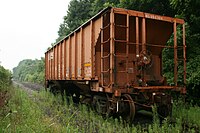Hopper car
This article's lead section may be too long. (November 2022) |

A hopper car (US) or hopper wagon (UIC) is a type of railroad freight car used to transport loose bulk commodities such as coal, ore, grain, and track ballast.[1][2][3] Two main types of hopper car exist: covered hopper cars, which are equipped with a roof, and open hopper cars, which do not have a roof.
This type of car is distinguished from a gondola car in that it has opening doors on the underside or on the sides to discharge its cargo. The development of the hopper car went along with the development of automated handling of such commodities, with automated loading and unloading facilities.
Covered hopper cars are used for bulk cargo such as grain, sugar, and fertilizer that must be protected from exposure to the weather. Open hopper cars are used for commodities such as coal, which can suffer exposure with less detrimental effect. Hopper cars have been used by railways worldwide whenever automated cargo handling has been desired. "Ore jennies" is predominantly a term for shorter open hopper cars hauling taconite by the Duluth, Missabe and Iron Range Railway on Minnesota's Iron Range.
A rotary car dumper permits the use of simpler and more compact (because sloping ends are not required) gondola cars instead of hoppers. Covered hoppers, though, are still in widespread use.
These are known as "Dual-purpose" hoppers, a type of the car referring to coal hopper car with rotary coupler on one end or on both ends. They can be used in both rotary or bottom-dump operations.
Gallery[edit]
- Non North American hopper cars
-
Swedish iron ore hopper (mineral wagon), built in 1900
-
BOBRN class hopper cars freight rakes used by Indian Railways
Special hopper trains[edit]
The Coke Express, a CSX unit train of hopper cars loaded with coke, with the words "Coke Express" painted on the sides of the hoppers.
Typical American freight car weights and wheel loads[edit]
| Common net car loads | Gross car weights | Wheel loads | ||||
|---|---|---|---|---|---|---|
| Short tons | Long tons | Tonnes | Pounds | Kilograms | Pounds | Kilograms |
| 80 | 71.4 | 72.6 | 220,000 | 100,000 | 27,500 | 12,500 |
| 100 | 89.3 | 90.7 | 263,000 | 119,000 | 32,875 | 14,912 |
| 101 | 90.2 | 91.6 | 268,000 | 122,000 | 33,500 | 15,200 |
| 111 | 99.1 | 100.7 | 286,000 | 130,000 | 35,750 | 16,220 |
| 125 | 111.6 | 113.4 | 315,000 | 143,000 | 39,375 | 17,860 |
Increase in wheel loads has important implications for the rail infrastructure needed to accommodate future grain hopper car shipments. The weight of the car is transmitted to the rails and the underlying track structure through these wheel loads. As wheel loads increase, track maintenance expenses increase and the ability of a given rail weight, ballast depth, and tie configuration to handle prolonged rail traffic decreases. Moreover, the ability of a given bridge to handle prolonged rail traffic also decreases as wheel loads increase.[4] The axle load is twice the wheel load.
Gallery[edit]
- North American hopper cars
-
The Coke Express rolls through a level crossing. Cars display both the CSX logo and the words COKE EXPRESS
-
Two-bay hopper cars of the Reading Railroad
-
NOKL hopper car at Pittsburg, Texas, in 2015
-
N&W ballast hopper car.
Etymology[edit]
The word "hopper", meaning a "container with a narrow opening at bottom", goes back to the thirteenth century,[5] and is found in Chaucer's story "The Reeve's Tale" (written late fourteenth century) in reference to a machine for grinding grain into flour.
See also[edit]
- CDA wagon
- Gravity wagon, also called a slant wagon
- Hopper barge
- Victorian Railways hopper wagons
References[edit]
- ^ "Covered Hopper Railcars". GATX Corporation. Archived from the original on 16 September 2010. Retrieved 11 September 2012.
- ^ "Small Cube Open-Top Hoppers and Gondolas". GATX Corporation. Archived from the original on 16 September 2010. Retrieved 11 September 2012.
- ^ "Covered Hopper Cars". Chicago Freight Car Leasing Company. Archived from the original on 16 April 2012. Retrieved 11 September 2012.
- ^ Bitzan, John D.; Tolliver, Denver D. (October 2001). "The Economics of Heavy Hopper Cars". Mountain-Plains.org. Mountain Plains. Archived from the original on 23 July 2011. Retrieved 7 August 2010.
- ^ "Hopper". Online Etymology dictionary.
Further reading[edit]
- Bernard Ciry, "Les wagons-trémies à céréales et à bogies", fr:Rail Miniature Flash, No. 632, Paris, Rigel Editions, juin 2018, pages 28-41.
External links[edit]
- Union Pacific #7801 – Photos and short history of an example of a typical self-clearing, open-top triple hopper
- Rail car manufacturing
- Guide to Rail Cars







